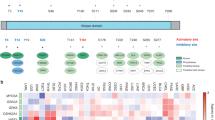Abstract
To investigate the possibility of differing roles for cyclins D1 and D2 in breast epithelial cells, we examined the expression, cell cycle regulation and activity of these two G1 cyclins in both 184 normal breast epithelial cells and T-47D breast cancer cells. Synchronisation studies in 184 cells demonstrated that cyclin D1 and cyclin D2 were differentially regulated during G1, with cyclin D2 abundance increasing by 3.7-fold but only small changes in cyclin D1 abundance observed. The functional consequences of increased cyclin D2 expression were examined in T-47D cells, which express no detectable cyclin D2. Induced expression of cyclin D2 resulted in increases in cyclin E expression, pRB phosphorylation and the percentage of cells in S-phase, while constitutive expression resulted in a consistent trend toward reduced dependence on serum for continued proliferation. Thus, cyclin D2 is a positive regulator of G1 progression in breast cells analogous to the well-documented effects of cyclin D1. Indeed, equimolar concentrations of inducible cyclin D1 and D2 resulted in quantitatively similar cell cycle effects. Marked divergence was found, however, in the CDKs activated by the two cyclins in breast epithelial cells. Cyclin D2 complexes contained a higher Cdk2/Cdk4 ratio than cyclin D1 complexes. The cyclin D2-associated kinase activity was largely inhibited by Cdk2-specific inhibitors and could phosphorylate histone H1, a substrate for Cdk2 but not for Cdk4 and Cdk6. Therefore, cyclin D2 preferentially activated Cdk2 in breast epithelial cells. In contrast, Cdk4 and Cdk6 were predominantly responsible for cyclin D1-associated kinase activity as previously reported. Thus, although cyclins D1 and D2 elicited similar effects on breast epithelial cell cycle progression they appeared to achieve this end via activation of different CDKs. This is the first evidence of cyclin D2 activating Cdk2 in mammalian cells thus providing further evidence that D-type cyclins are not necessarily redundant.
This is a preview of subscription content, access via your institution
Access options
Subscribe to this journal
Receive 50 print issues and online access
$259.00 per year
only $5.18 per issue
Buy this article
- Purchase on Springer Link
- Instant access to full article PDF
Prices may be subject to local taxes which are calculated during checkout
Similar content being viewed by others
Author information
Authors and Affiliations
Rights and permissions
About this article
Cite this article
Sweeney, K., Sarcevic, B., Sutherland, R. et al. Cyclin D2 activates Cdk2 in preference to Cdk4 in human breast epithelial cells. Oncogene 14, 1329–1340 (1997). https://doi.org/10.1038/sj.onc.1200951
Received:
Revised:
Accepted:
Issue Date:
DOI: https://doi.org/10.1038/sj.onc.1200951
Keywords
This article is cited by
-
QTLs associated with dry matter intake, metabolic mid-test weight, growth and feed efficiency have little overlap across 4 beef cattle studies
BMC Genomics (2014)
-
Expression of cyclin D2, P53, Rb and ATM cell cycle genes in brain tumors
Medical Oncology (2011)
-
Expression of Gli1 correlates with the transition of breast cancer cells to estrogen-independent growth
Breast Cancer Research and Treatment (2010)
-
B5, a novel pyrrole-substituted indolinone, exerts potent antitumor efficacy through G2/M cell cycle arrest
Investigational New Drugs (2010)
-
Cellular responses to ErbB-2 overexpression in human mammary luminal epithelial cells: comparison of mRNA and protein expression
British Journal of Cancer (2004)



